
The hummingbird hawk-moth is a species of hawk moth found across temperate regions of Eurasia. The species is named for its similarity to hummingbirds, as they feed on the nectar of tube-shaped flowers using their long proboscis while hovering in the air; this resemblance is an example of convergent evolution.

The insects of the beetle family Chrysomelidae are commonly known as leaf beetles, and include over 37,000 species in more than 2,500 genera, making up one of the largest and most commonly encountered of all beetle families. Numerous subfamilies are recognized, but the precise taxonomy and systematics are likely to change with ongoing research.
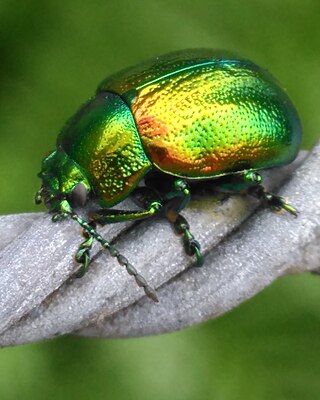
The tansy beetle is a species of leaf beetle. The common name derives from its main foodplant, tansy, but it can also use other wetland plants such as gypsywort and water mint. It measures 7.7–10.5 mm in length and has a characteristic bright metallic green colouration, with pitted elytra and a coppery tinge. In addition to the nominotypical subspecies, which repeats the specific name, C. graminis graminis, there are five further distinct subspecies of tansy beetle, which, collectively, have a Palearctic distribution, although in the majority of countries where it is found the species is declining. In the United Kingdom it is designated as 'Nationally Rare'. The stronghold population here is located along the banks of the river Ouse in York, North Yorkshire. Other, small, fenland populations exist at Woodwalton Fen and at Welney Wildfowl and Wetlands Trust (WWT) reserve.

The common pug(Eupithecia vulgata) is a moth of the family Geometridae. It is a common species across the Palearctic region, including the Near East and North Africa. It ranges from the Atlantic coast of Ireland and Portugal across Europe, the Middle East and Central Asia to the Russian Far East (Priamurje) and Korea.

The grey pug is a moth of the family Geometridae. It is found throughout the Palearctic region. It is also found in North America. Since it does not place any special demands on climatic conditions, special caterpillar food plants, geological subsoil or the like it is a typical species of almost any Hochstaudenflur, where it occurs in the herb layer, in bushes and even on deciduous trees. It can be found on forest edges and hedgerows, on heath, in rocky places and wetlands, parks and gardens, as well as in villages and town centres.

The latticed heath is a moth of the family Geometridae, belonging to the subfamily Ennominae, placed in the tribe Macariini. The genus was erected by Carl Linnaeus in his 1758 10th edition of Systema Naturae.

The scarlet lily beetle, red lily beetle, or lily leaf beetle, is a leaf beetle that eats the leaves, stem, buds, and flowers, of lilies, fritillaries and other members of the family Liliaceae. It lays its eggs most often on Lilium and Fritillaria species. In the absence of Lilium and Fritillaria species, there are fewer eggs laid and the survival rate of eggs and larvae is reduced. It is now a pest in most temperate climates where lilies are cultivated.

Galium verum is a herbaceous perennial plant of the family Rubiaceae. It is widespread across most of Europe, North Africa, and temperate Asia from Israel, Lebanon and Turkey to Japan and Kamchatka. It is naturalized in Tasmania, New Zealand, Canada, and the northern half of the United States. It is considered a noxious weed in some places.
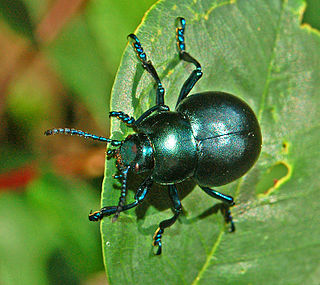
Timarcha is a genus of leaf beetles in the family Chrysomelidae, with more than 100 described species in three subgenera. The most widely known species is T. tenebricosa, the bloody-nosed beetle. All species are black, wingless organisms. Timarcha are herbivorous species, living mostly on plants belonging to Rubiaceae and Plumbaginaceae, although a few can feed on Brassicaceae and Rosaceae. Timarcha is the only member of the tribe Timarchini.

Xanthogaleruca luteola, commonly known as the elm-leaf beetle, is a beetle species in the family Chrysomelidae that is native to Europe but invasive in other parts of the world.

Agelastica alni, the alder leaf beetle, is a species of leaf beetle (Chrysomelidae) in the genus Agelastica. Agelastica alni is distributed in Europe, the Caucasus, Siberia, north-eastern Kazakhstan, and in the 19th century was introduced to the United States.

Cosmorhoe is a monotypic moth genus in the family Geometridae erected by Jacob Hübner in 1825. Its only species, Cosmorhoe ocellata, the purple bar, was described by Carl Linnaeus in his 1758 10th edition of Systema Naturae.

Autohaemorrhaging, or reflex bleeding, is the action of animals deliberately ejecting blood from their bodies. Autohaemorrhaging has been observed as occurring in two variations. In the first form, blood is squirted toward a predator. The blood of these animals usually contains toxic compounds, making the behaviour an effective chemical defence mechanism. In the second form, blood is not squirted, but is slowly emitted from the animal's body. This form appears to serve a deterrent effect, and is used by animals whose blood does not seem to be toxic. Most animals that autohaemorrhage are insects, but some reptiles also display this behaviour.

Polydrusus formosus is a species of broad-nosed weevil belonging to the family Curculionidae, subfamily Entiminae.

Chrysolina herbacea, also known as the mint leaf beetle, or green mint beetle, is a species of beetle in the family Chrysomelidae.

Chrysolina coerulans, also known as the blue mint beetle or blue mint leaf beetle, is a species of beetle in the family Chrysomelidae. It is a member of the subgenus Synerga of the genus Chrysolina. It is native to a wide range of countries between mid and eastern Europe and lives alongside rivers and in meadows, it feeds on various plant members of the mint family.
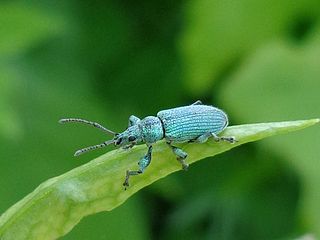
Phyllobius pomaceus is a species of short-nosed weevil commonly known as the nettle weevil.
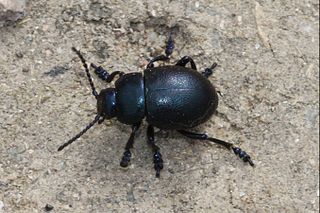
Timarcha goettingensis, commonly known as the Small Bloody-nosed Beetle or the Lesser Bloody-nosed Beetle is a species of leaf beetle native to Europe.
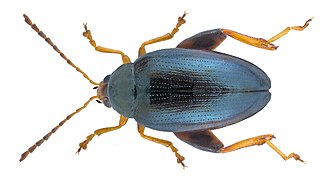
Psylliodes chrysocephala or Psylliodes chrysocephalus, commonly known as the cabbage-stem flea beetle, is a species of leaf beetle situated in the subfamily Galerucinae and the tribe Alticini.

Chrysolina haemoptera, also known as the plantain leaf beetle, is a species of leaf beetle in the genus Chrysolina. They are associated with plantains (Plantago), particularly Plantago coronopus.























